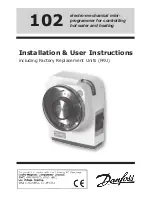
CT/L-14 Controller
13
Attention!
•
All connections and jumper installations should be carried out only when the equipment
is powered off and power supply is disconnected.
•
During mounting use only proper tools.
•
Cabling should be performed in accordance with general requirements for electrical
equipment.
•
Do not use the controller if it is not properly installed and connected.
7.2 Operation safety requirements
Operation should be performed in accordance with general electrical and work safety rules.
Do not use!
•
The controller under conditions that do not comply with the requirements of Sect. 2 of
this Manual
.
•
The controller at supply voltage that does not comply with the requirements of Sect. 3 of
this Manual.
•
The device in hostile environment that contains acids, alkalis, oils etc.
Power supply should be used accordingly to safety rules given in the Operation manual.
8 INSTALLATION
Installation should be performed in accordance with work safety noted in Sect. 7.1.
Installation should be done in accordance with local building requirements.
8.1 Cable lengths
Cables for installation are shown in Table 3.
Table 3. Cables used for installation
N
Equipment
Cable
length, m,
max
Cable type
Cross
section,
mm² min.
Cable example
1 Ethernet (IEEE 802.3)
100
Four twisted
pairs (starting
from Category 5)
0.2
4×2×0.52
F/UTP2-Cat5e
2
Reader, card capture reader,
AI-01
indication block
50 (total) Twisted pairs
(starting from
Category 5)
2×2×0.52
F/UTP2-Cat5e
CL-201
lock controller,
AU-
05
system time display
1200 (total)
3 Power source
10
Twin cable
0.75
Flat cord with
sheath and outer
sheath of PVC
4
RC-button (“Exit”); Door
sensor (reed switch);
Additional equipment
30
Twin cable
0.2
RAMCRO
SS22AF-T 2x0.22
CQR-2
5 Remote control
40
Eight-core cable
0.2
CQR CABS8
8x0.22c
7 Lock
30
Double-core
cable
0.75
PVC twin cable
2×0.75
8 Turnstile
30
Six-core cable
0.2
CQR CABS6
6x0.22c
9 Vehicle checkpoint
30
Four-core cable
0.2
CQR CABS4
4x0.22c
Recommendations:
•
Mounting of communication lines should comply with
EIA/TIA
RS-422A/485
standards.
•
Do not lay cables at a distance less than 50 cm from a source of electromagnetic interference.















































